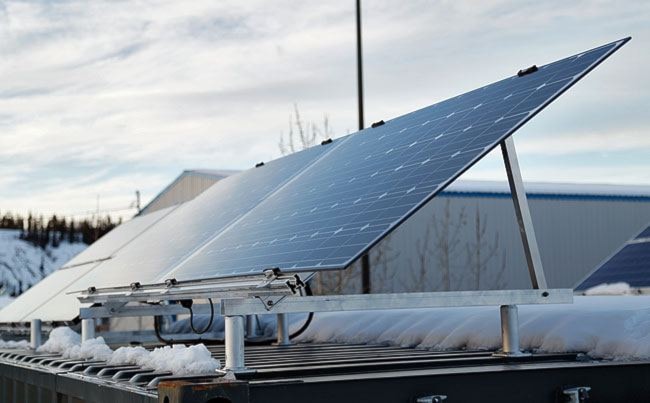A new research project in Whitehorse is aiming to shed light on how different solar panels work in northern climates.
Solvest, a Yukon-based solar company, has partnered with the Cold Climate Innovation Centre at Yukon College and Triniti Technology, a local technology solutions company, to install a three-kilowatt solar array at the YuKonstruct makerspace in Whitehorse.
The array includes four different types of solar panel modules. Data will be collected from each of the modules to determine which technology works best at producing electricity in different conditions.
Ben Power, co-founder of Solvest, said solar technology is typically tested in places like California, Arizona or Spain.
“The problem with that is the solar conditions in those areas are quite different to what we experience up north,” he explained, referring to the dark northern winters and the long arc the sun makes across the sky in summertime.
Stephen Mooney, director of Cold Climate Innovation, agreed that there has been little in-situ testing of solar technology in the North.
“We’ve never had four (technologies) in the exact same test, same area, that close together.”
The four panel types are called monocrystalline, polycrystalline, bi-facial monocrystalline and thin film.
“Almost all solar installations in the Yukon are done with polycrystalline to date,” Power said. “But that may not be the most efficient for the Yukon.”
He explained that monocrystalline panels produce more power per square foot, and may be better in cloudy conditions, which Whitehorse has been experiencing more of in recent years. The downside is they’re more expensive.
Bi-facial panels are pricier still, but they have crystals on each side, meaning both faces of the panel can absorb light. Power said that could be useful during Yukon winters, because snow often acts like a mirror beneath solar panels, reflecting sunlight up onto the underside of the panel. And bi-facial panels may also do better at absorbing light from different directions during the long summer days.
Thin film panels are the cheapest of the lot, Power explained, but they’re also the least efficient. They might be a good option for someone living on a country residential lot with some extra space, he said.
Solvest has now installed 12 modules at the YuKonstruct compound in Whitehorse, where they’ll help supply some of the makerspace’s electricity demand. Data are being collected from each module to see how the different panels perform, particularly in low light and cloudy conditions.
Mooney said they’ll run the project for at least a year, though the data will be analyzed starting this spring.
The output of each of the panel types can be tracked in real time at www.yukonsolarresearch.ca.
The project has a price tag of about $22,000. Cold Climate Innovation and Triniti Technology are each paying half the cost.
Mooney said he hopes the project will help Yukoners figure out what type of solar technology might work for them, depending on how much electricity they want to produce and how much space they have.
Power said the project will help his company offer the right technology to each of its clients. And he hopes it will spur some renewed interest in renewable power.
“There’s a lot of misconceptions about solar,” he said. “A number of these conceptions I think can be at least partially addressed.”
He pointed out that the cost of solar panels has declined in recent years, and that solar power systems are long-lived. He said they sometimes come with 25-year warranties.
But residential solar power is still a niche market in the Yukon. Shane Andre, director of the energy branch with the Department of Energy, Mines and Resources, said there are currently just 17 solar systems connected to the grid as part of the territory’s microgeneration program. There are off-grid households with solar panels as well, but those are harder to count. Andre said the installation costs are still the biggest obstacle for many people. “These systems have decreased in price a lot over the years,” he said. “But it’s still a significant investment.”
He said it takes an average of 25 years for people to pay off the cost of the panels.
Contact Maura Forrest at
maura.forrest@yukon-news.com
